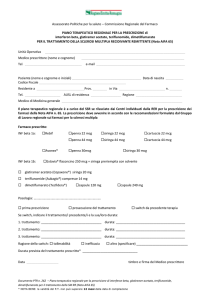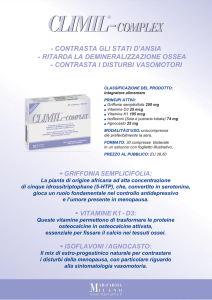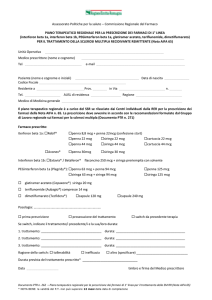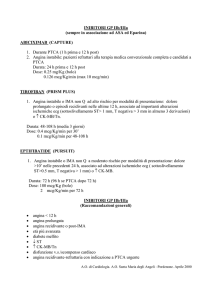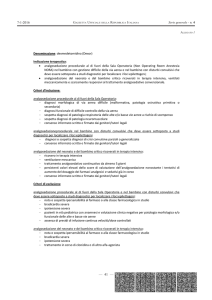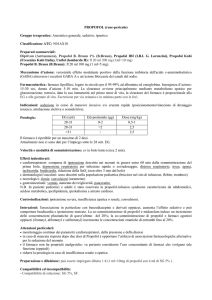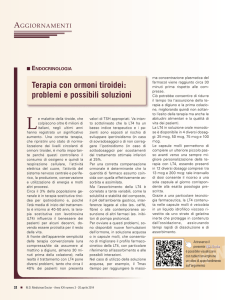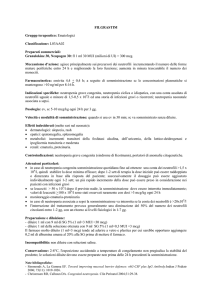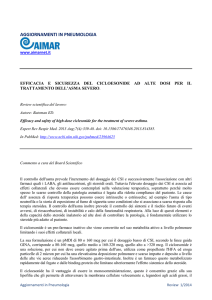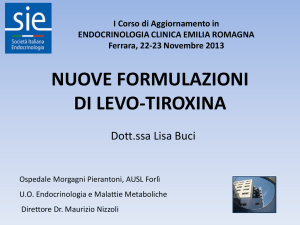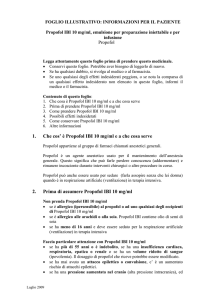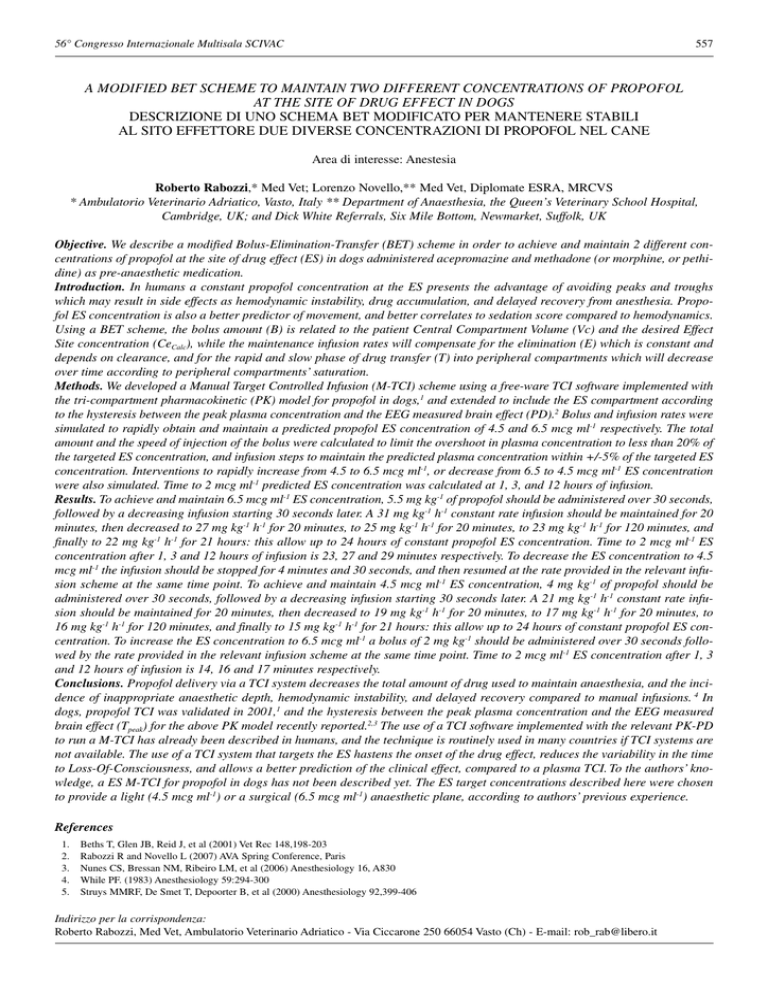
56° Congresso Internazionale Multisala SCIVAC
557
A MODIFIED BET SCHEME TO MAINTAIN TWO DIFFERENT CONCENTRATIONS OF PROPOFOL
AT THE SITE OF DRUG EFFECT IN DOGS
DESCRIZIONE DI UNO SCHEMA BET MODIFICATO PER MANTENERE STABILI
AL SITO EFFETTORE DUE DIVERSE CONCENTRAZIONI DI PROPOFOL NEL CANE
Area di interesse: Anestesia
Roberto Rabozzi,* Med Vet; Lorenzo Novello,** Med Vet, Diplomate ESRA, MRCVS
* Ambulatorio Veterinario Adriatico, Vasto, Italy ** Department of Anaesthesia, the Queen’s Veterinary School Hospital,
Cambridge, UK; and Dick White Referrals, Six Mile Bottom, Newmarket, Suffolk, UK
Objective. We describe a modified Bolus-Elimination-Transfer (BET) scheme in order to achieve and maintain 2 different concentrations of propofol at the site of drug effect (ES) in dogs administered acepromazine and methadone (or morphine, or pethidine) as pre-anaesthetic medication.
Introduction. In humans a constant propofol concentration at the ES presents the advantage of avoiding peaks and troughs
which may result in side effects as hemodynamic instability, drug accumulation, and delayed recovery from anesthesia. Propofol ES concentration is also a better predictor of movement, and better correlates to sedation score compared to hemodynamics.
Using a BET scheme, the bolus amount (B) is related to the patient Central Compartment Volume (Vc) and the desired Effect
Site concentration (CeCalc), while the maintenance infusion rates will compensate for the elimination (E) which is constant and
depends on clearance, and for the rapid and slow phase of drug transfer (T) into peripheral compartments which will decrease
over time according to peripheral compartments’ saturation.
Methods. We developed a Manual Target Controlled Infusion (M-TCI) scheme using a free-ware TCI software implemented with
the tri-compartment pharmacokinetic (PK) model for propofol in dogs,1 and extended to include the ES compartment according
to the hysteresis between the peak plasma concentration and the EEG measured brain effect (PD).2 Bolus and infusion rates were
simulated to rapidly obtain and maintain a predicted propofol ES concentration of 4.5 and 6.5 mcg ml-1 respectively. The total
amount and the speed of injection of the bolus were calculated to limit the overshoot in plasma concentration to less than 20% of
the targeted ES concentration, and infusion steps to maintain the predicted plasma concentration within +/-5% of the targeted ES
concentration. Interventions to rapidly increase from 4.5 to 6.5 mcg ml-1, or decrease from 6.5 to 4.5 mcg ml-1 ES concentration
were also simulated. Time to 2 mcg ml-1 predicted ES concentration was calculated at 1, 3, and 12 hours of infusion.
Results. To achieve and maintain 6.5 mcg ml-1 ES concentration, 5.5 mg kg-1 of propofol should be administered over 30 seconds,
followed by a decreasing infusion starting 30 seconds later. A 31 mg kg-1 h-1 constant rate infusion should be maintained for 20
minutes, then decreased to 27 mg kg-1 h-1 for 20 minutes, to 25 mg kg-1 h-1 for 20 minutes, to 23 mg kg-1 h-1 for 120 minutes, and
finally to 22 mg kg-1 h-1 for 21 hours: this allow up to 24 hours of constant propofol ES concentration. Time to 2 mcg ml-1 ES
concentration after 1, 3 and 12 hours of infusion is 23, 27 and 29 minutes respectively. To decrease the ES concentration to 4.5
mcg ml-1 the infusion should be stopped for 4 minutes and 30 seconds, and then resumed at the rate provided in the relevant infusion scheme at the same time point. To achieve and maintain 4.5 mcg ml-1 ES concentration, 4 mg kg-1 of propofol should be
administered over 30 seconds, followed by a decreasing infusion starting 30 seconds later. A 21 mg kg-1 h-1 constant rate infusion should be maintained for 20 minutes, then decreased to 19 mg kg-1 h-1 for 20 minutes, to 17 mg kg-1 h-1 for 20 minutes, to
16 mg kg-1 h-1 for 120 minutes, and finally to 15 mg kg-1 h-1 for 21 hours: this allow up to 24 hours of constant propofol ES concentration. To increase the ES concentration to 6.5 mcg ml-1 a bolus of 2 mg kg-1 should be administered over 30 seconds followed by the rate provided in the relevant infusion scheme at the same time point. Time to 2 mcg ml-1 ES concentration after 1, 3
and 12 hours of infusion is 14, 16 and 17 minutes respectively.
Conclusions. Propofol delivery via a TCI system decreases the total amount of drug used to maintain anaesthesia, and the incidence of inappropriate anaesthetic depth, hemodynamic instability, and delayed recovery compared to manual infusions. 4 In
dogs, propofol TCI was validated in 2001,1 and the hysteresis between the peak plasma concentration and the EEG measured
brain effect (Tpeak) for the above PK model recently reported.2,3 The use of a TCI software implemented with the relevant PK-PD
to run a M-TCI has already been described in humans, and the technique is routinely used in many countries if TCI systems are
not available. The use of a TCI system that targets the ES hastens the onset of the drug effect, reduces the variability in the time
to Loss-Of-Consciousness, and allows a better prediction of the clinical effect, compared to a plasma TCI. To the authors’ knowledge, a ES M-TCI for propofol in dogs has not been described yet. The ES target concentrations described here were chosen
to provide a light (4.5 mcg ml-1) or a surgical (6.5 mcg ml-1) anaesthetic plane, according to authors’ previous experience.
References
1.
2.
3.
4.
5.
Beths T, Glen JB, Reid J, et al (2001) Vet Rec 148,198-203
Rabozzi R and Novello L (2007) AVA Spring Conference, Paris
Nunes CS, Bressan NM, Ribeiro LM, et al (2006) Anesthesiology 16, A830
While PF. (1983) Anesthesiology 59:294-300
Struys MMRF, De Smet T, Depoorter B, et al (2000) Anesthesiology 92,399-406
Indirizzo per la corrispondenza:
Roberto Rabozzi, Med Vet, Ambulatorio Veterinario Adriatico - Via Ciccarone 250 66054 Vasto (Ch) - E-mail: [email protected]
Abstract presentato al 56° Congresso Nazionale Multisala SCIVAC, Rimini 1‐3 Giugno 2007 SCHEMA BET MODIFICATO PER MANTENERE DUE DIVERSE CONCENTRAZIONI EFFETTORIALI DI PROPOFOL NEL CANE Autori: R. Rabozzi (Med Vet), L. Novello (Med Vet, Dip ESRA, MRCVS) Obiettivo. Descrivere per la prima volta due schemi BET modificati per raggiungere e mantenere due diverse concentrazioni effettoriali di propofol in cani premedicati con acepromazina e metadone (o morfina, o meperidina). Introduzione. Il principale vantaggio di mantenere una concentrazione effettoriale di propofol stabile è quello di prevenire le oscillazioni, spesso responsabili di effetti collaterali e risvegli accidentali, garantendo un piano anestetico stabile. Instabilità cardiorcolatoria, accumulo di farmaco e prolungamento dei tempi di risveglio sono alcuni degli effetti collaterali documentati. Nell’uomo poi l’utilizzo della concentrazione effettoriale permette di meglio prevenire i movimenti intraoperatori rispetto al monitoraggio delle variazioni emodinamiche, oltre che meglio corelare con il livello di sedazione misurato da una scala a punteggio (es. OAA/S). Nello schema BET l’entità del bolo (B) viene determinata in base al volume iniziale di distribuzione (volume centrale) e alla concentrazione effettoriale desiderata. Le velocità di infusione invece servono a bilanciare la quantità di farmaco eliminata, che è costante nel tempo e dipende dalla clearance, e la quantità di farmaco trasferita (T) ai compartimenti rapido e lento, che diminuisce nel tempo man mano che i compartimenti si riempiono di farmaco. Materiali e metodi. Con l’aiuto di un software TCI aggiornato con la farmacocinetica tricompartimentale del propofol nel cane (Beths et al. 2001), a cui abbiamo aggiunto il compartimento effettoriale e la relativa costante basata sull’isteresi tra picco plasmatico e massimo effetto sull’elettroencefalogramma (Nunes et al. 2006; Rabozzi & Novello 2007), abbiamo sviluppato un’infusione manuale a target effettoriale (M‐TCI). Bolo ed infusione sono stati calcolati per raggiungere rapidamente le concentrazioni di 4,5 e 6,5 mcg kg‐1 , e mantenerle costanti nel tempo. Quantità del bolo e velocità della sua somministrazione sono stati calcolati in modo da limitare l’eccesso iniziale di concentrazione a meno del 20% della concentrazione target prevista, mentre velocità e durata delle infusioni sono state calcolate per limitare l’oscillazione di concentrazione entro il 5% della concentrazione target prevista. Sono state anche simulate le azioni necessarie per passare da uno schema all’altro in corso d’opera, oltre che previsti i tempi necessari perché la concentrazione ‐1
scenda a 2 mcg ml dopo 1, 3 e 12 ore di infusione (context sensitive decrement time). Risultati. Per raggiungere e mantenere una concentrazione effettoriale di 6,5 mcg ml‐1 bisogna somministrare 5,5 mg kg‐1 nell’arco di 30 ‐1 ‐1
‐1 ‐1
secondi seguiti, a distanza di 30 secondi dal termine del bolo, da un’infusione a 31 mg kg h per 20 minuti, a 27 mg kg h per 20 ‐1 ‐1
‐1 ‐1
‐1 ‐1
minuti, a 25 mg kg h per 20 minuti, a 23 mg kg h per 120 minuti e infine a 22 mg kg h per 21 ore. Questo schema garantisce fino ‐1
a 24 ore di concentrazione effettoriale costante. Perché la concentrazione plasmatica diminuisca a 2 mcg ml dopo 1, 3 e 12 ore di ‐1
‐1
infusione ci vogliono 23, 27 e 29 minuti. Per passare da 6,5 mcg ml a 4,5 mcg ml bisogna interrompere l’infusione per 4 minuti e 30 secondi per poi riprendere secondo lo schema inferiore (cioè quello per 4,5 mcg ml‐1) in corrispondenza del punto temporale raggiunto ‐1
‐
al momento del passaggio. Per raggiungere e mantenere una concentrazione plasmatica di 4,5 mcg ml bisogna somministrare 4 mg kg
1
‐1 ‐1
nell’arco di 30 secondi seguiti, a distanza di 30 secondi dal termine del bolo, da un’infusione a 21 mg kg h per 20 minuti, a 19 mg kg‐
1 ‐1
h per 20 minuti, a 17 mg kg‐1 h‐1 per 20 minuti, a 16 mg kg‐1 h‐1 per 120 minuti e infine a 15 mg kg‐1 h‐1 per 21 ore. Quest’ultima velocità può essere mantenuta per ulteriori 11 ore garantendo in tutto fino a 12 ore di concentrazione plasmatica costante. Perché la ‐1
‐1
concentrazione plasmatica diminuisca a 1 ng ml dopo 1, 2, 3 e 12 ore di infusione ci vogliono 11 minuti. Per passare da 1,4 ng ml a 1,8 ‐1
‐1
ng ml bisogna somministrare 1,5 mcg kg nell’arco di 10 secondi e quindi passare allo schema superiore in corrispondenza del punto temporale raggiunto al momento del passaggio. Questo schema garantisce fino a 24 ore di concentrazione effettoriale costante. Per ‐1
‐1
‐1
passare da 4,5 mcg ml a 6,5 mcg ml bisogna somministrare 2 mg kg in bolo e poi riprendere secondo lo schema superiore (cioè ‐1
quello per 6,5 mcg ml ) in corrispondenza del punto temporale raggiunto al momento del passaggio. Perché la concentrazione ‐1
plasmatica diminuisca a 2 mcg ml dopo 1, 3 e 12 ore di infusione ci vogliono 14, 16 e 17 minuti. Conclusioni. E’ stato dimostrato che l’uso di un sistema TCI, rispetto ad una infusione manuale, permette di ridurre la quantità totale di propofol necessaria a mantenere l’anestesia, oltre che l’incidenza di effetti collaterali quali piani anestetici insufficienti, instabilità emodonamica e risvegli ritardati (White 1983). Mentre la farmacocinetica del propofol nel cane è stata validata nel 2001 (Beths et al.), la farmacodinamica per tale modello farmacocinetico è stata riportata solo recentemente utilizzando l’isteresi tra picco plasmatico e massimo effetto sull’EEG (Nunes et al. 2006; Rabozzi & Novello 2007). L’utilizzo di un software TCI per simulare una M‐TCI è già stato riportato nell’uomo, e tale tecnica viene utilizzata clinicamente in molti paesei dove non sono disponibili pompe abilitate alla TCI. L’utilizzo di un taget effettoriale permette di velocizzare l’instaurarsi dell’effetto del farmaco, oltre che ridurre la variabilità di insorgenza della perdita del riflesso di raddrizzamento (LORR) e mantenere più efficacemente nel tempo l’effetto desiderato (Struys et al. 2000). Fino ad oggi non è mai stato descritta una M‐TCI effettoriale per il cane. I 2 target descritti sono stati scelti perché, in base all’esperienza ‐1
degli autori, sono quelli che meglio permettono di ottenere in tutti i soggetti uno stato di anestesia leggera (4,5 mcg ml ) o di anestesia ‐1
chirurgica (6,5 mcg ml ). Downloaded free from http://www.isvra.org Abstract presentato al 56° Congresso Nazionale Multisala SCIVAC, Rimini 1‐3 Giugno 2007 SCHEMA BET MODIFICATO PER LA SOMMINISTRAZIONE DI PROPOFOL NEL CANE (Autori: R. Rabozzi, Med Vet; L. Novello, Med Vet, Dip ESRA, MRCVS) 6,5 mcg ml‐1 (anestesia chirurgica) 5,5 mg kg‐1 in 30 secondi OPPURE 40 mg kg‐1 h‐1 per 15 minuti Per scendere a 4,5 Per salire a 6,5 4,5 mcg ml‐1 (anestesia leggera) 4 mg kg‐1 in 30 secondi
OPPURE 40 mg kg‐1 h‐1 per 8 minuti 31 mg kg‐1 h‐1 per 20 minuti 21 mg kg‐1 h‐1 per 20 minuti 27 mg kg‐1 h‐1 per 20 minuti 19 mg kg‐1 h‐1 per 20 minuti 25 mg kg‐1 h‐1 per 20 minuti 23 mg kg‐1 h‐1 per 120 minuti 22 mg kg‐1 h‐1 per 21 ore Downloaded free from http://www.isvra.org Fermare l’infusione per 4 minuti e 30 secondi, e poi passare allo schema 4,5 mcg ml‐1 Somministrare 17 mg kg‐1 h‐1 2 mg kg in 30 secondi, per 20 minuti ‐1
‐1
‐1
e poi passare allo 16 mg kg h schema 6,5 mcg ml‐1 per 120 minuti 15 mg kg‐1 h‐1 per 21 ore

